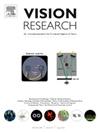大细胞选择适应对空间距离压缩的贡献
IF 1.4
4区 心理学
Q4 NEUROSCIENCES
引用次数: 0
摘要
视觉处理早期的地形图保留了视觉刺激的空间关系,但这些视觉方向之间的度量关系不能直接获得。为了研究大细胞通路在度量空间视觉中的作用,我们采用了一个适应范式。暴露于60赫兹闪烁的光盘阵列(主观上看不见)诱导了随后呈现的点对之间的感知距离的系统压缩。当自适应优先调制低空间频率信道时,这种压缩最强,这与调谐到低空间和高时间频率的瞬态信道的特性一致。至关重要的是,当适配器由两个青色晶格组成,在接近等亮度的品红背景上旋转时,这种压缩被减弱,正如一个全局运动方向识别任务所证实的那样。当测试点与背景是等光时,出现了相同的模式,排除了测试适配器相似度作为关键因素的可能性。最后,一个在黄色背景上闪烁的红绿适配器在3hz下诱导压缩,而不是在60hz下。这种分离与大细胞神经元的已知特性一致,大细胞神经元对高时间频率的等光红绿调制不敏感,但可以对慢速的等光红绿调制做出反应。这些发现揭示了大细胞通路在度量空间视觉中的新作用。本文章由计算机程序翻译,如有差异,请以英文原文为准。
The contribution of magnocellular selective adaptation to spatial distance compression
Topographic maps early in visual processing preserve the spatial relations of visual stimuli but the metric relationships between these visual directions is not directly accessible. To investigate the magnocellular pathway’s role in metric spatial vision, we employed an adaptation paradigm. Exposure to a 60 Hz flickering disc array (subjectively invisible) induced a systematic compression in the perceived distance between subsequently presented dot pairs. This compression was strongest when adaptation preferentially modulated low spatial frequency channels, consistent with the properties of transient channels tuned to low spatial and high temporal frequencies. Crucially, this compression was attenuated when the adaptor consisted of two cyan lattices rotating on a magenta background near isoluminance, as confirmed by a global motion direction discrimination task. The same pattern emerged when test dots were isoluminant with the background, ruling out test-adaptor similarity as a critical factor. Finally, an isoluminant red-green adaptor flickering on a yellow background induced compression at 3 Hz, but not at 60 Hz. This dissociation aligns with the known properties of magnocellular neurons, which are insesitive to high temporal frequency isoluminant red-green modulation, but can respond to slow isoluminant red-green modulations. These findings reveal a novel role of the magnocellular pathway in metric spatial vision.
求助全文
通过发布文献求助,成功后即可免费获取论文全文。
去求助
来源期刊

Vision Research
医学-神经科学
CiteScore
3.70
自引率
16.70%
发文量
111
审稿时长
66 days
期刊介绍:
Vision Research is a journal devoted to the functional aspects of human, vertebrate and invertebrate vision and publishes experimental and observational studies, reviews, and theoretical and computational analyses. Vision Research also publishes clinical studies relevant to normal visual function and basic research relevant to visual dysfunction or its clinical investigation. Functional aspects of vision is interpreted broadly, ranging from molecular and cellular function to perception and behavior. Detailed descriptions are encouraged but enough introductory background should be included for non-specialists. Theoretical and computational papers should give a sense of order to the facts or point to new verifiable observations. Papers dealing with questions in the history of vision science should stress the development of ideas in the field.
 求助内容:
求助内容: 应助结果提醒方式:
应助结果提醒方式:


